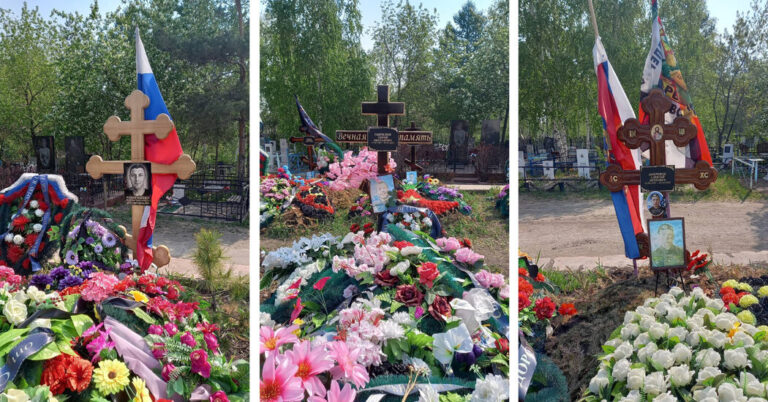Covering any topic remotely is always a journalistic challenge. Covering a world-altering war unleashed by a repressive state, without being physically present in that place, is particularly difficult.
Soon after Russia’s invasion of Ukraine, the Kremlin effectively criminalized reporting that diverged from its narrative, forcing a large proportion of independent reporters working in the country to leave. From outside of Russia, we have sifted through social media posts, dialed up those in our ever-shrinking pool of sources and read the tea leaves of communiqués and statistics to piece together a portrait of a country consumed by violent, dramatic change.
Documenting Russia’s war recruitment has been exceptionally challenging.
In April, our reporting reached a breakthrough: A trusted human rights lawyer provided us with a series of documents that contained the personal details of 197 Russian inmates who had enlisted last year in return for a pardon. The details of the inmates from the high-security Penal Colony No. 6, known as IK6, gave us a window into Russia’s secretive campaign to bolster its decimated forces with tens of thousands of convicts.
Up until then, journalistic accounts had been forced to rely on the scattered individual testimonies of the few inmate fighters or their relatives who had agreed to talk, usually on the condition of anonymity, out of fear for their safety. Other reports were based on the accounts of deserters or prisoners of war held in Ukraine, whose testimonies could be influenced by fear of retribution from both their captors and their home country.
By using a sample from one prison, of average size and conditions for its type, we could reach general conclusions about Russia’s inmate fighters. The documents gave us a chance to lift the veil of state secrecy and get a sense of who these men were, and what paths their lives had taken after recruitment. Our article on these men was published in The New York Times last week.
The scale of the challenge was daunting. On top of the usual obstacles of reporting on Russia’s war, we had to locate some of the most socially and economically marginalized people in the country. Most of the men came from rural areas and poor families. Many had spent years behind bars in an abusive prison, weakening their social and family ties, and making them suspicious of the outside world.
To start, we created a spreadsheet and listed the name of each recruit. Then we began to track down the details of their individual lives.
Our team’s data reporter, Oleg Matsnev, combed through Russia’s online court records, which helped us confirm the authenticity of the documents and understand the nature of the men’s crimes. Oleg’s methodical scouring of Russian social media proved vital: We were able to confirm the deaths of many of the men by finding obituaries posted by local authorities or relatives.
But using social media was tricky. These were men who tend to leave few digital footprints. In jail, most of the inmates had access to illicit, if irregular, use of cellphones. They often kept numerous social media accounts, which they opened and then abandoned as their phones were confiscated or passed to someone else.
That meant that two people on our reporting team, Alina Lobzina and Ekaterina Bodyagina, had to manually contact hundreds of social media accounts associated with the enlisted men or their relatives. It was eight months of painstaking work.
Slowly, our spreadsheet filled up. Eventually, we were able to trace the fates of 172 of the men on our list, in varying degrees of detail.
We ended up speaking with 16 survivors, and the relatives and friends of many others. Some fighters who agreed to talk helped confirm the fates of their companions whom we couldn’t reach. Relatives and friends of those who died shared valuable, if emotionally charged, accounts of what their loved ones had gone through.
Much of the previous media coverage of Russian prison recruitment had focused on former inmates who had committed brutal murders. The recruits were portrayed as having little chance of survival during combat. And the public perception of the survivors had been shaped by those who had committed brutal crimes after they returned home.
But what emerged from our research and reporting was a much more complex portrait, of men who were largely invisible to Russian society and the world.
For example, although the promise of pardon has attracted many inmates imprisoned for murder (one in three IK6 recruits was serving time for that crime), the most common offense was breaking Russia’s strict narcotics laws.
While we found that the death rate among IK6 recruits was extremely high for any Western military — at least one in four was killed — most did survive, albeit with injuries.
And although some survivors do break the law again after returning home, relatively minor offenses, such as drunken driving and drug possession, are far more common than violent crimes.
“Everyone focuses on extreme outlying cases, ignoring the mundane,” said my co-author Alina. “We have succeeded in creating a more broad picture that helps to understand these men as humans.”
Getting the men and their loved ones to agree to be interviewed was the biggest challenge. Many wanted to put the war and the prison behind them; others said they were told by commanders to keep quiet, or they feared breaking Russia’s draconian censorship laws.
Building trust with each source took weeks, sometimes months. We omitted the last names of all the former inmates we quoted to protect them against possible retaliation. Hearing their stories allowed us to understand the complexity of their decision to join the war.
“Their constant question to me was: Why tell their stories?,” my co-author Ekaterina told me. “I told them that people should not be dying in silence.”

